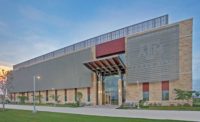Best Project
Best Higher Education/Research: National Veterans Resource Center at Syracuse University

Photo courtesy Syracuse University
National Veterans Resource Center (NVRC) at Syracuse University
Syracuse, N.Y.
BEST PROJECT
OWNER: Syracuse University
LEAD DESIGN FIRM: SHoP Architects
GENERAL CONTRACTOR: LeChase Construction Services LLC
CIVIL ENGINEER: GHD
STRUCTURAL ENGINEER: Thornton Tomasetti
MEP ENGINEER: M/E Engineering PC
CURTAIN WALL DESIGN CONSULTING: CDC
BIM SERVICES: Tech Valley Engineering PLLC
As a first-of-its-kind, multi-use facility, the three-story, 115,000-sq-ft building provides a singular space for the university’s veteran- and military-focused programs and organizations to work, learn, gather and celebrate.
Though the structure appears as a natural complement to its surroundings, the constraints of multiple adjacent campus buildings made early engagement with trade partners a must to optimize project phasing and procurement. Pull-planning at the shop drawing stage determined the exact sequence for each trade to work on site and for material logistics. With extremely limited onsite storage, deliveries and concrete were scheduled to be completed before the morning rush hour.

Photo courtesy Syracuse University
Collaborative planning identified ways to reduce project costs by approximately $14 million and still conform with LEED Gold standards.

Photo by James Ewing Photography
Aluminum replaced steel for the grid of the glass curtain wall, which underwent extensive weather tests using mock-ups to ensure an airtight and watertight design that also met insulation requirements. A wood feature wall outside the auditorium was changed from continuous glulam beams to shorter planks placed at geometrically precise angles, which also provides easier access to mechanical system elements in the ceiling.

Photo by James Ewing Photography
The project had ambitious goals for participation by service-disabled veteran-owned businesses (SDVOB) as well as women- and minority-owned businesses (M/WBE). To meet these goals, the team engaged with economic development organizations to help individuals gain relevant construction certifications and provided site tours for program trainees. The efforts helped the team exceed its goals, including 15% SDVOB participation—more than double the original target.
To ensure a safe worksite, the project team augmented standard practices with efforts such as projectwide presentations by trade contractors on the dangers associated with their work. The team provided training on ways to prevent cuts and implemented a voluntary stretch and flex program to help workers loosen up prior to lifting, bending or twisting. These efforts contributed to an incident-free jobsite during the project’s final months, with no lost-time accidents over nearly 477,000 work hours.





